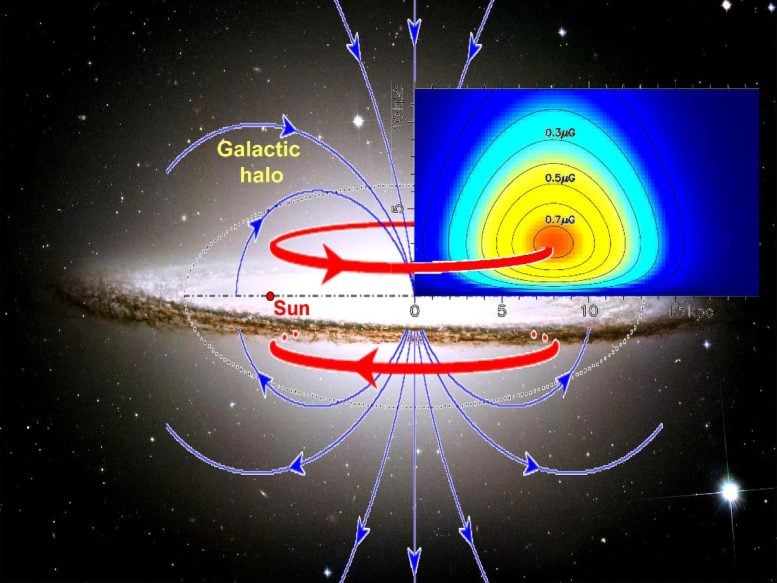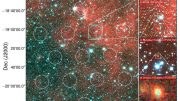
Magnetic fields in the halo of the Milky Way have a toroidal structure, extending in the radius range of 6000 light-years to 50,000 light-years from the Galaxy center. The Sun is at about 30,000 light-years. Credit: NAOC
Astrophysicists have discovered large magnetic toroids in the Milky Way’s halo, which impact cosmic ray propagation and the physics of interstellar space. Their research, based on extensive Faraday rotation data, reveals that these toroids extend across the galaxy, confirming the presence of significant toroidal magnetic fields.
A long-standing unsolved question at the frontier of astronomy and astrophysics research is the origin and evolution of cosmic magnetic fields. It has been selected as one of the key areas of investigation for many major world-class radio telescopes, including the Square Kilometer Array (SKA) currently under construction. Determining the large-scale magnetic field structures in the Milky Way has been a major challenge for many astronomers in the world for decades.
Discovery of Magnetic Toroids
In a new study published in The Astrophysical Journal on May 10, Dr. Jun Xu and Prof. Jinlin Han from the National Astronomical Observatories of the Chinese Academy of Sciences (NAOC) have revealed huge magnetic toroids in the halo of the Milky Way, which are fundamental for cosmic ray propagation and provide crucially constraint on the physical processes in the interstellar medium and the origin of cosmic magnetic fields.
Prof. Han, a leading scientist in this research field, has determined the magnetic field structures along the spiral arms of the Galactic disk through a long-term project of measuring the polarization of pulsars and their Faraday effects. In 1997, he found a striking anti-symmetry of the Faraday effects of cosmic radio sources in the sky with respect to the coordinates of our Milky Way galaxy, which tells that the magnetic fields in the halo of the Milky Way have a toroidal field structure, with reversed magnetic field directions below and above the Galactic plane.
Challenges in Measuring Magnetic Fields
However, to determine the size of these toroids or the strength of their magnetic fields has been a tough task for astronomers for decades. They suspected that the anti-symmetry of the sky distribution of Faraday effects of radio sources could be produced merely by the interstellar medium in the vicinity of the Sun because pulsars and some nearby radio-emission objects, which are quite near to the Sun, show Faraday effects consistent with anti-symmetry. The key is to show whether or not magnetic fields in the vast Galactic halo had such a toroidal structure outside the vicinity of the Sun.
Innovative Research Methods
In this study, Prof. Han innovatively proposed that the Faraday rotation from the interstellar medium in the vicinity of the Sun could be counted by the measurements of a good number of pulsars, some of which have been obtained recently by the Five-hundred Aperture Spherical radio Telescope (FAST) by themself, and then could be subtracted the contribution from the measurements of background cosmic sources. All Faraday rotation measurement data in the past 30 years were collected by Dr. Xu.
Through data analysis, scientists found that the anti-symmetry of the Faraday rotation measurements caused by the medium in the Galactic halo exists in all the sky, from the center to the anti-center of our Milky Way, which implies that the toroidal magnetic fields of such a odd symmetry have a huge size, existing in a radius range from 6000 light-years to 50,000 light-years from the center of the Milky Way.
Conclusion and Impact
This study has significantly advanced our understanding of the Milky Way’s physics and marks a milestone in research on cosmic magnetic fields.
Reference: “The Huge Magnetic Toroids in the Milky Way Halo” by J. Xu and J. L. Han, 10 May 2024, The Astrophysical Journal.
DOI: 10.3847/1538-4357/ad3a61









Galactic Anomaly
I guess one question is, does this new magnetic anomaly on this scale, affect the apparently burgeoning of theories of the latest physics, and was this forecast ?
We are aware of lesser objects, planets and the like having magnetic fields, like our Earth, and the Sun, but on this galactic proportion, why not ?
Could be a product of cooling-enhanced gravitational field flows along the spin axis and equatorial plane, where charged matter is radiated at the poles and absorbed along the galactic equator, with the heavier positive charges taking a much shorter path than the negative charges. Haven’t thought about it too much though.
A typical spiral galaxy reminds me of a blurred re-scaled model of a nucleon itself modeled as a spinning omni-retroreflector, which to me is absolutely a holographic concept.
Could be I’ve over-thought it, but there seemed to be a need for a conceptual linkage between the absolute smallest of invisibly-small particles (presumably Planck scale) with any possible wavelength of field carrier particle field effect, and the way to do that most concretely is to have the field generator particle rotate as it is radiated. A commonly-sized spiral galaxy like the MW seems to fit well with a rotation rate matching the E/G ratio for protons. A mix of longer rotation rates (only three rotation rates needed for galactic, cluster and baryonic waves) and initial phases, where the difference between a cosine wave and a sine wave is the difference between a fundamentally attractive force and the opposite, could explain much of the dark sector. Not sure if this qualifies as a “CCC” model. Preference here is to enforce a cyclic/steady-state condition, so recent suggestions of doubling the supposed age of the universe is just fitting n=2 cycles into the run.
Just to add some finish here on being concrete in the particle image for this concept, it may be possible to visualize a radiated rotating field effect, outlining a full progression of phases as a distributed effect exhibiting a source-wise stationary ripple-form as a radiative elaboration to the standard Newtonian inverse-square “well,” using a longitudinally-rotating radiated field generator particle bearing Planck-sized binary-valued surface regions respectively carrying positive and negative potential effects. I don’t suppose this is any sort of arcane math, just the simplest way for me to go from the invisible to the universal.
Could be a problem, but when I think of conserving flux quantization for all forms of field information, I can’t help but think of the 1st drawing in Vonnegut’s “Breakfast of Champions.”
the obvious question that seems to be sidestepped here is field strength, how many Tesla are these things ? To be detectable at this scale in space time surely they must be fairly strong